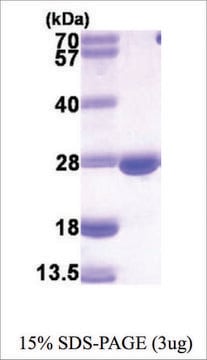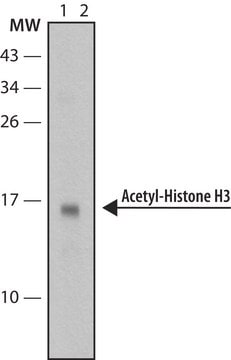Alle Fotos(1)
Wichtige Dokumente
EPI001
Histone Acetyltransferase (HAT) Activity Assay Kit
100 assays in 96 well plates
Synonym(e):
HAT Activity, Histone Acetyltransferase Activity
Anmeldenzur Ansicht organisationsspezifischer und vertraglich vereinbarter Preise
Alle Fotos(1)
About This Item
Empfohlene Produkte
Verwendung
100 assays in 96 well plates
Versandbedingung
wet ice
Lagertemp.
−20°C
Allgemeine Beschreibung
Histone acetyltransferases (HATs) have critical roles in cellular functions and are involved in the regulation of gene transcription, differentiation, and proliferation. The HAT Activity Colorimetric Assay Kit offers a convenient, non-radioactive system for a rapid and sensitive detection of HAT activity in mammalian samples. The kit includes an active Nuclear Extract (NE) to be used as a positive control, HAT cofactor, acetyl-CoA, and all downstream cofactors and substrates. Acetylation of a peptide substrate by active HAT releases the free form of CoA, which then serves as an essential coenzyme for producing NADH. NADH can easily be detected spectrophotometrically upon reacting with a soluble tetrazolium dye. The detection can be continuous, and therefore, is suitable for kinetic studies. The kit provides all reagents and a simple, straightforward protocol for a complete assay.
Leistungsmerkmale und Vorteile
- Sensitive and reliable assay
- Utilizes colorimetric methods
- Sample type: cell and tissue lysates
- Species reactivity: mammalian
- Suitable for individual tests or high throughput assays and kinetic studies
- Easy and simple procedure: combine nuclear extract or protein sample with reagents, incubate, and read absorbance
- Convenient 96-well microplate format
- Continuously measures HAT activity; suitable for kinetic studies
- No HDAC interference; crude nuclear extract can be used directly
Ähnliches Produkt
Lagerklassenschlüssel
12 - Non Combustible Liquids
Hier finden Sie alle aktuellen Versionen:
Analysenzertifikate (COA)
Lot/Batch Number
Die passende Version wird nicht angezeigt?
Wenn Sie eine bestimmte Version benötigen, können Sie anhand der Lot- oder Chargennummer nach einem spezifischen Zertifikat suchen.
Besitzen Sie dieses Produkt bereits?
In der Dokumentenbibliothek finden Sie die Dokumentation zu den Produkten, die Sie kürzlich erworben haben.
Hongxiu Li et al.
Blood, 123(10), 1487-1498 (2014-01-18)
Follicular lymphoma (FL) constitutes the second most common non-Hodgkin lymphoma in the western world. FL carries characteristic recurrent structural genomic aberrations. However, information regarding the coding genome in FL is still evolving. Here, we describe the results of massively parallel
Koji Maemura
Nihon rinsho. Japanese journal of clinical medicine, 71(12), 2124-2129 (2014-01-21)
Cardiovascular function exhibits circadian oscillation. Furthermore, the onset time and severity of cardiovascular diseases exhibit diurnal variation. The internal circadian clock whose center exists in the suprachiasmatic nucleus regulates this circadian variation. Many studies have reported that night shift workers
Hiroshi Watanabe et al.
Nihon rinsho. Japanese journal of clinical medicine, 71(12), 2091-2096 (2014-01-21)
Aging alters a broad spectrum of physiological, endocrine, and behavioral rhythms, and the close relationship between age-associated disease and disrupted circadian rhythms has been shown. Circadian rhythms are regulated by a set of clock genes and mutations in clock genes
Atsuhito Nakao
Nihon rinsho. Japanese journal of clinical medicine, 71(12), 2153-2157 (2014-01-21)
IgE-mediated immediate-type allergic reactions in the skin show a diurnal rhythm, although the regulatory mechanisms are poorly understood. In mammals, the circadian rhythms are driven by the circadian clock system consisting of the light-entrained central clock located in the suprachiasmatic
Igor Efimov et al.
FEBS letters, 588(5), 701-704 (2014-01-21)
We describe a simple method for the determination of heme protein reduction potentials. We use the method to determine the reduction potentials for the PAS-A domains of the regulatory heme proteins human NPAS2 (Em=-115 mV ± 2 mV, pH 7.0)
Unser Team von Wissenschaftlern verfügt über Erfahrung in allen Forschungsbereichen einschließlich Life Science, Materialwissenschaften, chemischer Synthese, Chromatographie, Analytik und vielen mehr..
Setzen Sie sich mit dem technischen Dienst in Verbindung.








